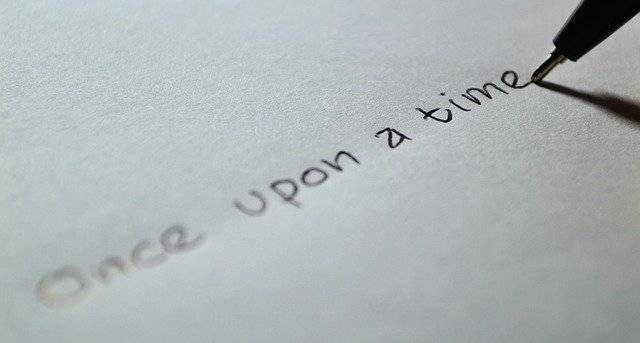This post deals with filing of copyright registration application for protection of Sound recording. As elaborated in our previous post, audio books are protected under copyright act as sound recordings. With the rise of various platform for audio books, like Audible, Google Play Books, Kobo Books, Bookmobile, etc., the market for audiobooks is growing with tremendous pace. In this scenario, it is recommended that writers should file a copyright registration application for registering their audiobooks under copyright law.
Either the writer of the book or the publisher or any other person who has taken rights from the writer or publisher to convert the book into an audiobook may be the owner of the audiobook and can file an application for registration of the said audiobook. As the post is written for the ease of the writers, we presume that the rights in the audiobook are owned by the writer and the writer is himself filing an application for registration of copyright in the said audiobook.
Process of Filing Application for Copyright Registration
The Indian Copyright Office provides for offline and online filing of applications for copyright registration in India. In India, a separate copyright registration application is to be filed for each sound recording. Keeping in mind the promotional/sample clips and marketing materials of the audiobook, writer may choose to file separate applications for the entire book and for such samples/clips.
Application for registration of copyright is to be filed under Form XIV, provided under the First Schedule of the Copyright Rules 2013. Application for copyright registration must be submitted with all the required documents (as discussed below) and prescribed fees.
Process of Filing Online Application for Copyright Registration
Application for copyright registration may be filed on copyright office’s website, copyright.gov.in.
For better understanding of the filing process, let’s consider an example of a book, titled “FunIP” authored by Dr. Kalyan C Kankanala, published in 2012 by Literators Publishing. Dr. Kalyan has himself converted the said book into audiobook and is himself filing application for registering copyright under the category of sound recording. He published his audiobook with the same publisher in 2012 itself.
For filing an application for sound recording, the writer needs to follow the following steps:
1. The writer needs to click on to the “e-filing of Application” option, available on left side of the home page, under the category of “Online Services”. Then the writer should create an account with copyright office and need to sign-in to his account. Online registration may also be done here.
Screenshot of Dr. Kalyan’s form for creating an account with Indian Copyright Office is provided below.
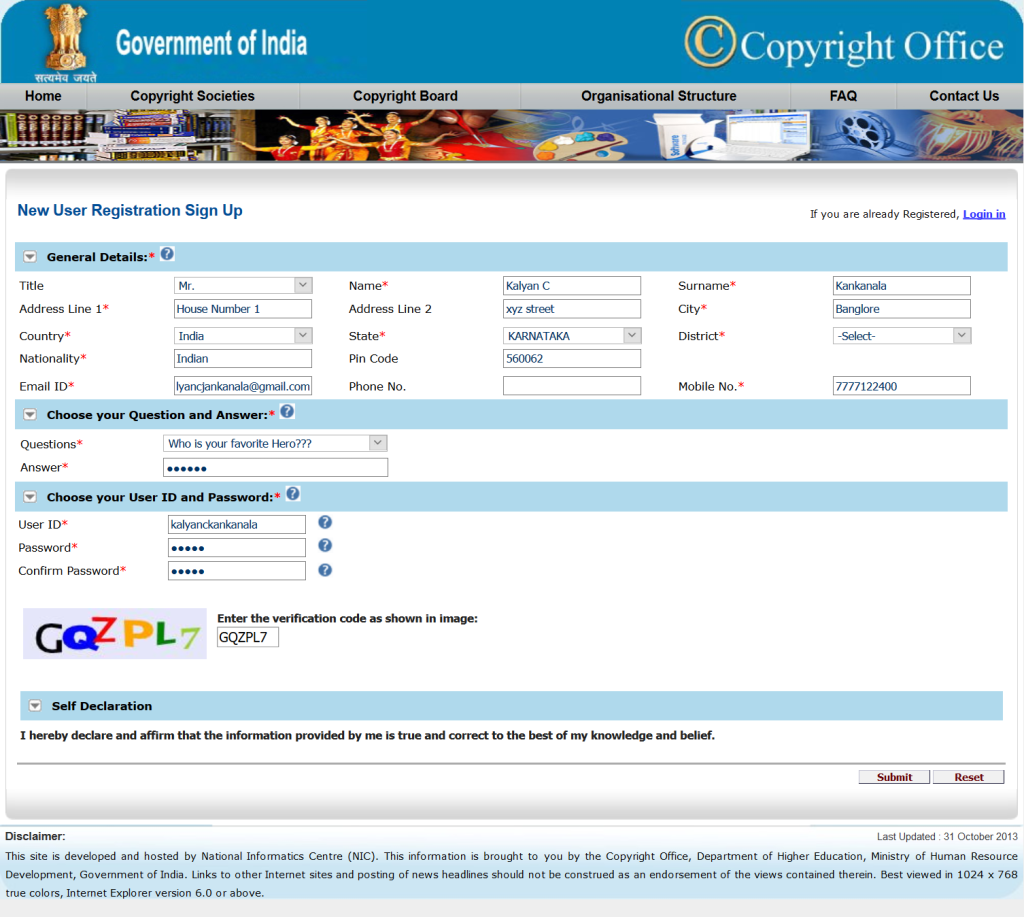
2. After creating an account, the writer needs to login to his/her account and click on “e-filing of Application” option, available on left side of the home page, under the category of “Online Services”. Then the writer should click on the “Click here for online Copyright Registration” option available in the account.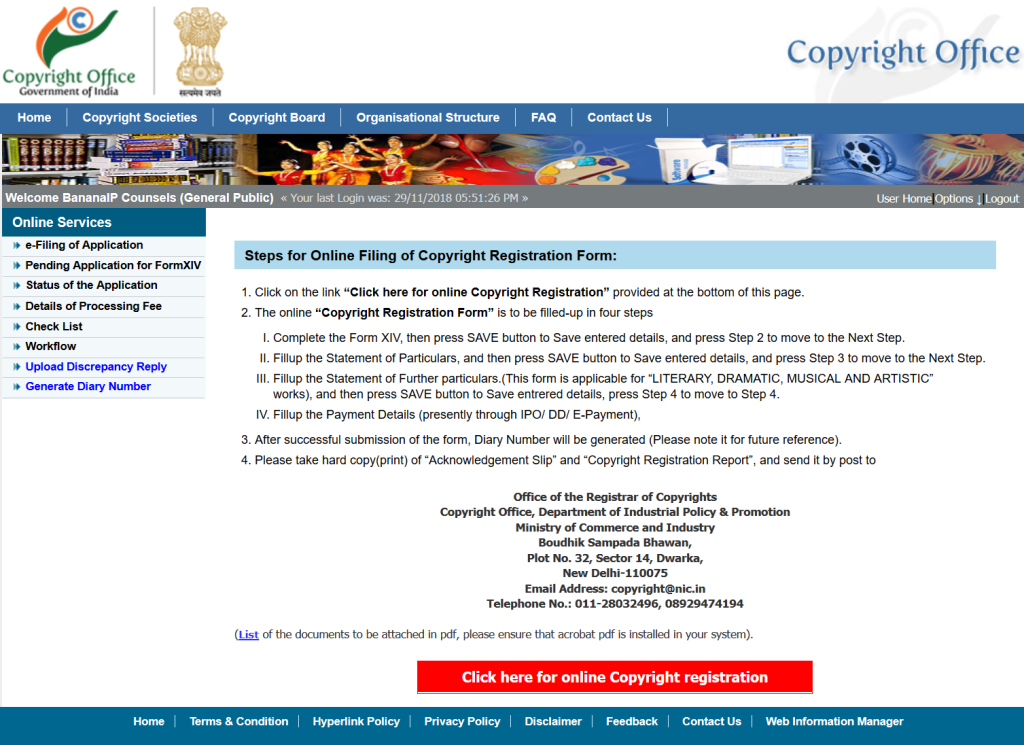
3. After clicking on “Click here for online Copyright Registration” option, Form XIV will appear on the screen.
In Column 2 of Form XIV, the writer needs to provide his name and other details of the persons who hold an interest in copyright of the book. People like publishers, creator of audio book etc., may hold interest in the audiobook. The writer should also send Form XIV and statement of particulars (basically the whole copyright registration application) to each person who has an interest in the book.
In present example, Dr. Kalyan is the writer of the book and has himself created the audio book, but the publisher of the book which is converted into the audiobook also owns interest in the audiobook. So Dr. Kalyan has to provide details of Literators Publishing in Column 2 of Form XIV and needs to send the copyright registration application to Literators Publishing.
In Column 3 of Form XIV, the writer needs to provide his address of communication. If the writer is a foreign resident, he has to provide a communication address in India. A foreign writer may mention the address of his agent, attorney or any other address in India as his communication address.
Then after filling the said details, the writer should read and agree to the undertakings provided in the form, save the details and move to statement of particulars.
Screenshot of Dr. Kalyan’s Form XIV for FunIP is provided below for reference.
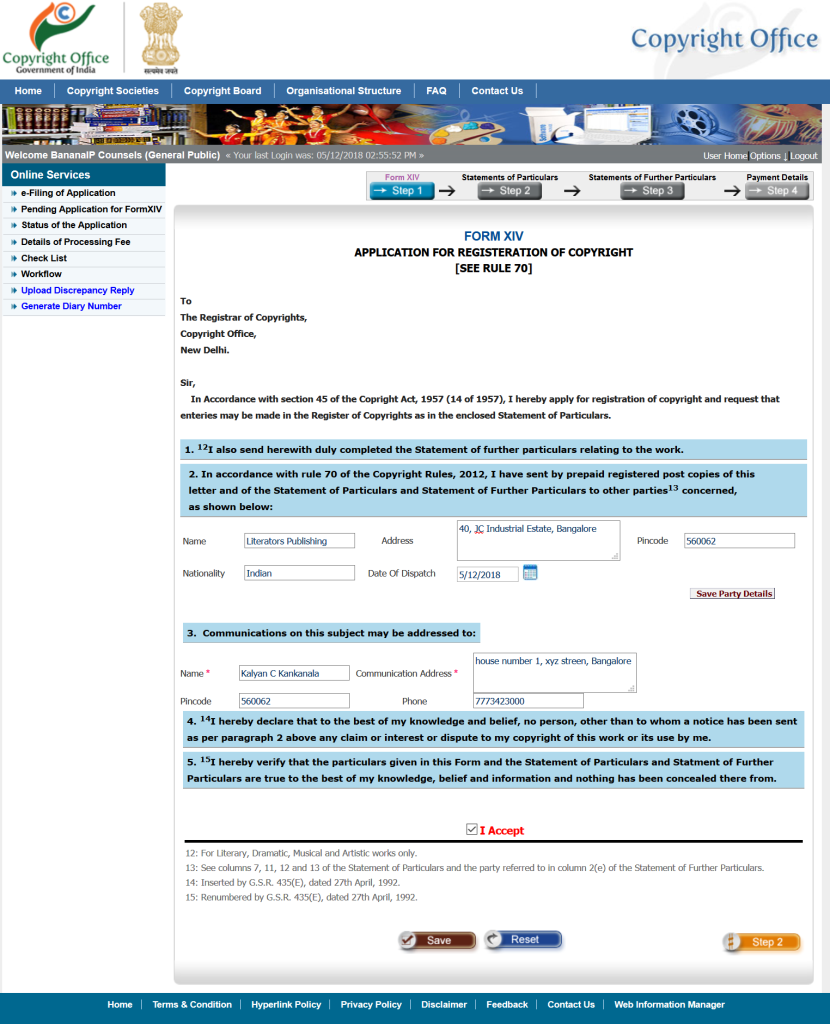
4. After Form XIV, the writer needs to fill the statement of particulars, which requires him to provide various details regarding the copyrighted work and his/her ownership, including nature of the work, the writer’s interest in the work, language of the work, etc.
Details regarding information to be filled in each column is provided in the table below.
| Column No. | Information to be filled |
| 1. | To be filled by Copyright Office once the work is entered into the Register of Copyright. This column is not available in online form. |
| 2. | Writer should provide his complete name, address and nationality. In present example, Dr. Kalyan has to provide his name, details and nationality. |
| 3. | Writer should provide nature of interest in the copyright of the work. The writer has to select category as an “author” of the work, if he has himself crated the audiobook or an “owner” of the work if he has hired someone to create the audiobook on his instructions. |
| 4. | The writer should mention “Sound recording” as the appropriate class of work. |
| 5. | The title which appears on the work should be exactly mentioned here. In present example, Dr. Kalyan has to provide “FunIP” as the title of the audiobook. |
| 6. | Language of the work is to be mentioned here. In present example, Dr. Kalyan’s audiobook is in English language and hence he has to write “English” as the language of the audiobook. |
| 7. | Writer has to mention the name, address and nationality of the person(s) who has created or authored the work or was involved in the creation/authorship of the work should be entered here. In case there is more than one author, the details of every such person should be mentioned. It is also important to note that only a natural person (human being) can be the author of the work. The name and details of the person who actually created the work should be mentioned in this column. In present example, Dr. Kalyan has himself created the audiobook and hence he has to mention his name and details in this column. |
| 8. | The writer should provide the status of the work at the time of filing the application, i.e. whether the work is published or unpublished. In present example, the audiobook was published in 2012, hence Dr. Kalyan has to select “Published” as the status of the audiobook. |
| 9. | Details of the publisher need to be mentioned here, if the work is already published. If work is not published then writer may write “NIL” in this column. In present example, the audiobook is published by Literators Publishing and hence Dr. Kalyan ha to mention details of Literators Publishing in this column. |
| 10. | Details of the subsequent publisher (if any) have to be submitted along with the latest year of publication. If no subsequent publication is there then writer may write “NIL” in this column. |
| 11. | Details of all the persons holding various rights/interest in the work need to be mentioned in this column. If the writer owns all the rights in the work, his details can be mentioned again. If the writer is a partnership firm, name, details of each partner may be mentioned in this column, along with their share in the copyright. In present case, being a publisher Literators Publishing has interest in the audiobook and hence Dr. Kalyan has to provide their details in this Column. |
| 12. | If any person is authorized to assign or licence the copyright, on behalf of the owner, the name, address and nationality of such person may be indicated. If not, ‘NIL’ or ‘N/A’ may be indicated. In present example, Dr. Kalyan has not authorised any person to assign or license the book on his behalf and hence he will mention “NIL” in this column. |
| 13-16 | These columns are relevant for artistic work and are not required for litereary works. |
| 17. | This is a non-mandatory column and writer may write any remarks relating to the work in this column. Remarks relating to originality or elaborating the content of the work may be written in this column. In present example, Dr. Kalyan may decide to provide a brief description of the audiobook in this column. |
The writer must provide all the required details, as described above, and then move to next step.
Screenshot illustrating Statement of Particulars in Dr. Kalyan’s application is provided below.
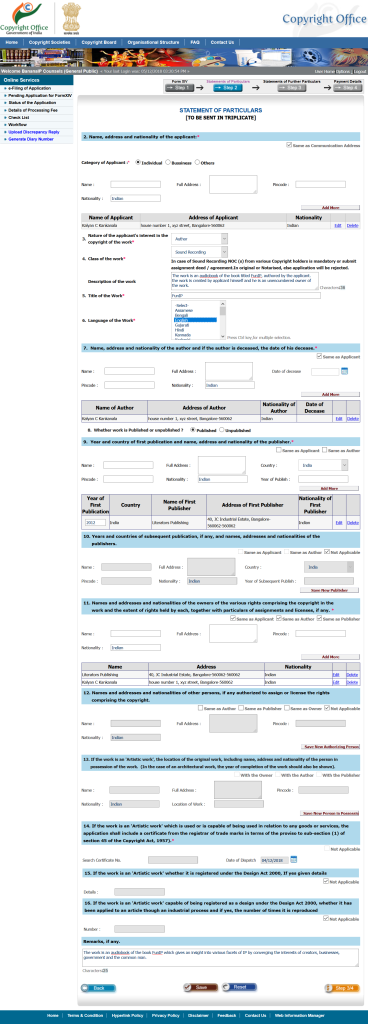
5. Unlike Literary and Artistic works, statement of further particulars is not required in case of sound recording and hence the writer will be directly redirected to the payment option.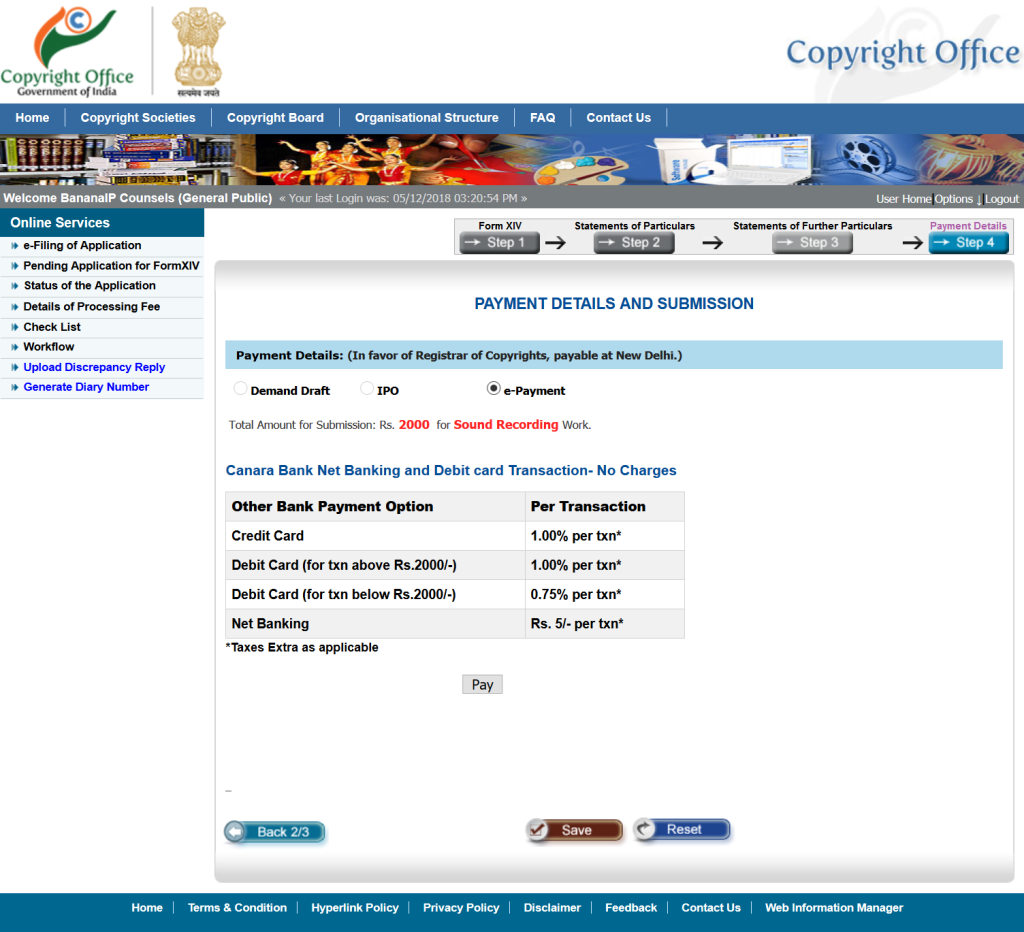
The prescribed fees for filing a copyright registration application for literary work is INR 10,000.
6. The writer must also provide certain documents along with the application for registration of the copyright. The following documents are required to be sent to the copyright office along with the print out of the application form, within 30 days from the date of filing of the online application:
- Copy of the form, generated online
- 2 Copies of the work (audiobook)
- DD/IPO of Rs. (as applicable) per work (only if the application for copyright registration is filed offline)
- NOC from various copyright holders or copy of agreement (deed of assignment). Writer may also file an undertaking stating that he is the copyright holder of the original book on which the audiobook is based.
- NOC from publisher if work published and publisher is different from applicant.
- If the application is being filed through attorney, a specific Power of Attorney in original duly signed by the applicant and accepted by the attorney
It is recommended that the writer should send a cover letter along with all the documents for the ease of the copyright office. Cover letter may contain Diary Number (if application is filed online), name and details of the writer and the list of documents send along with the application.
In present example, Dr. Kalyan needs to send a cover letter, copy of his application form, 2 copies of the work, an undertaking stating that he is copyright holder of the original book and the NOC from the publisher.
As he is the sole creator of the audiobook and is filing the application himself, the NOC from the abovementioned list is irrelevant.
Currently, the Copyright Office does not provide a facility to submit the documents online and hence the writer is required to take the printout of the form and send it to the copyright office along with all the required documents. Form is to be sent to the address provided below.
Process of Filing Offline Application for Copyright Registration
The writer may also send or directly hand over an application for copyright registration to the copyright office. The application must be sent on the below address, along with Form VIX and the statement of particulars. The application must be accompanied by all the required documents and prescribed fees.
Registrar of Copyrights
Copyright Office
Department of Industrial Policy & Promotion
Ministry of Commerce and Industry
Boudhik Sampada Bhawan,
Plot No. 32, Sector 14, Dwarka,
New Delhi-110075
The requirements and fees for filing offline copyright registration application is the same as that of the online application. All the forms required for filing copyright registration application can be downloaded here.
We will be elaborating the process of copyright registration in our subsequent post.
This post is authored by Arjun Kansal (Associate, BananaIP Counsels)
Note: If you are a writer and would like us to answer specific questions, please write to contact@bananaip.com with the subject: Copyrights and Writers.
Suggested Reading
- Chapter 3, Fun IP, Fundamentals of Intellectual Property, Dr. Kalyan C. Kankanala (2012).
Next Post – https://www.bananaip.com/ip-news-center/a-writer-by-any-other-name/
Previous Post – https://www.bananaip.com/ip-news-center/if-i-could-copyright-my-art-copyrights-and-writers-part-6/

